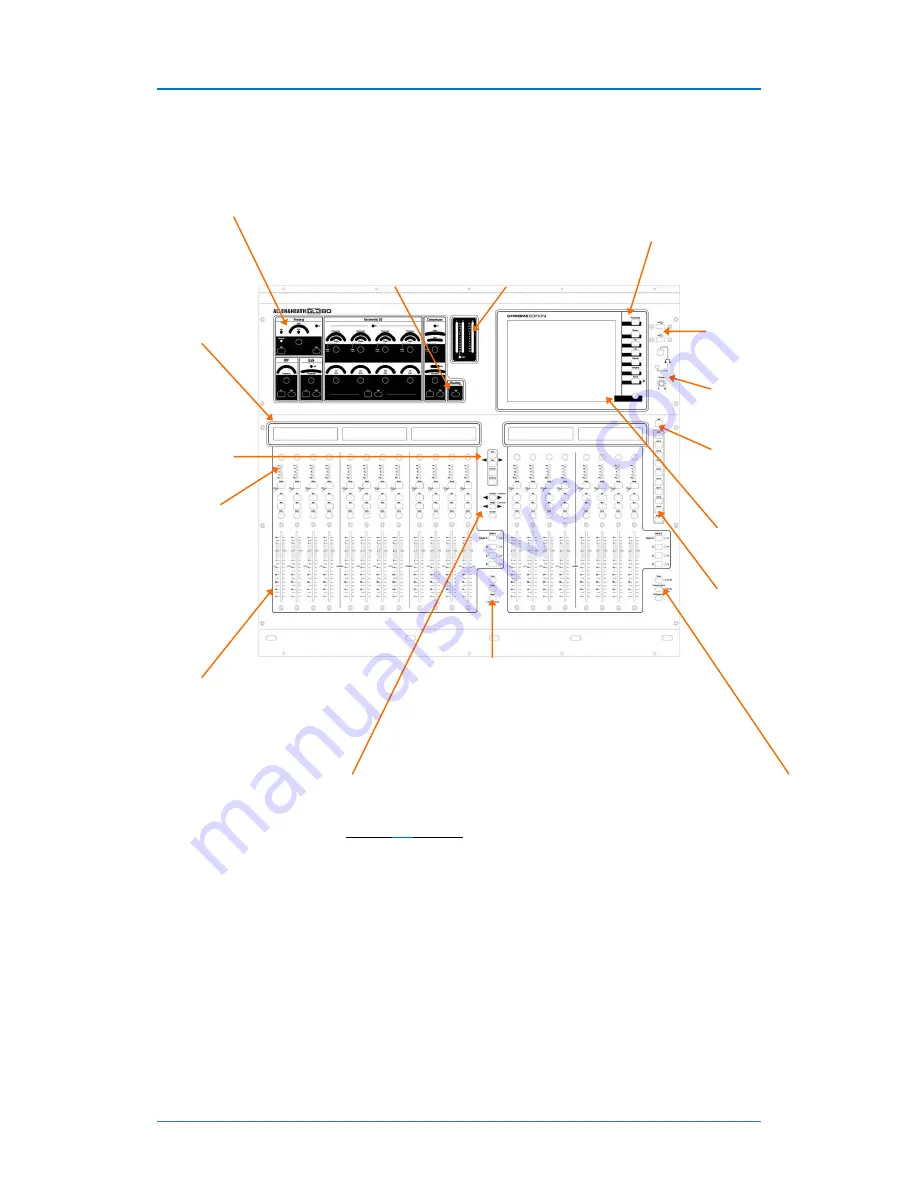
GLD
Chrome Edition
User Guide
10
AP9989 iss.1
GLD Chrome Mixer controls
Copy/Paste/Reset
Hold down Copy and press any
Sel
or
Mix
key to put its related mix or processing
parameters on to the clipboard. Then hold down
Paste and press a strip
Sel
or
Mix
key to paste its
contents to that channel. Hold Reset and press a key
to reset the related parameters to factory default.
Hold Reset and push a
fader
to set it to ‘0’ or off.
Channel Processing Strip
Analogue style processing
control section presenting the main controls for the
Preamp, HPF, Gate, PEQ and Compressor. Press the strip
Sel
key to access the processing for the input or master
assigned to it. Further parameter control is available using
the touch screen
Processing
screen.
Touch Screen
For status display, system
setup and memory management. To see
details and a graphical view of the
processing for the channel or master
currently selected make sure it is in
Processing
mode. The keys select the
screen mode. Use the rotary control to
adjust the value of a highlighted parameter.
Routing
select key to display the
assignments and sends for the
Sel
ected strip in the touch screen
while in
Processing
mode.
Main / PAFL meters
Fader Banks
2 / 3 groups of
motorised faders with 4 layers each (80
control strips on GLD-80, 112 on GLD-
112). Provides control of the Input
channel, FX return, Mix master, DCA,
engineer’s Wedge or IEM monitor, or
MIDI assigned using the
Setup /
Control
screen.
Mute
mutes the channel assigned to
the strip. It affects pre and post-fade
sends. The DCA indicator lights when
the channel is muted by a DCA master
assigned to it.
Sel
opens the channel processing for
the selected strip.
Mix
presents the sends for the selected
strip on faders and shows the related
assignments and pre/post settings in
the strip LCD displays.
PAFL
selects either PFL (pre-fade
listen) or AFL (after fade listen)
according to preferences set in the
Setup / Audio
screen. Input overrides
output (mix) PAFL.
Strip LCD display
to
show channel status
information and user
defined Name and
Colour.
Press to Talk
Talkback source and
destination is
assigned using the
Setup / Audio
screen.
USB ports
For
transferring Show
files, Libraries and
event logs, stereo
playback and
recording to USB,
and for updating
system firmware.
Assign
and
Pre/Post
access keys for the
selected mix.
While a
Mix
is active:
Hold down
Assign
and press strip
Mix
keys to
toggle the assignments on or off.
Hold down
Pre/Post
and press strip
Sel
keys to
toggle sends pre or post fade.
Toggle all on/off or pre/post while a master is
selected by pressing the master strip
Mix
or
Sel
key instead of the channel keys.
The touch screen lower toolbar displays the
currently selected mix. You can return to the
Main mix by turning the selected
Mix
off, or by
turning on then off any other
Mix
key.
Alt View
Hold down to view the channel or
socket numbers in place of the name in the LCD
displays. Set this preference in the
Setup /
Control
screen.
Strip rotary controls
Their function is selected
using these keys
– Gain,
Pan, Custom 1 and 2
(assignable using the
Setup / Control
screen).
Strip meters
The top
red indicator lights when
a peak is detected at
any point in the channel
signal path. These
meters also display RTA
activity while in GEQ on
Faders mode.
SoftKeys
User
assignable functions
using the
Setup /
Control
screen.
Headphones
Level
control and ¼” and
3.5mm sockets.
Safes
Make one or more channels
safe from Scene recall by holding
down the Safes key and then
pressing channel
Mix
keys. A
Safes Map
is also available to
make selected parameters safe.
Freeze in Layers
Hold down then
press strip
Mix
keys to temporarily
keep a channel visible across all
layers. To assign channels to
strips use the
Setup / Control
screen.
GEQ on Faders
Presents the
GEQ for a
Sel
ected mix on the
faders. Press to toggle between
high and low frequencies.
Frequency values are shown on the
strip LCD displays. The mix master
fader is presented on the right hand
strip while in this mode.
Help
Touch the
?
button to open the
built-in
Help Manual

























